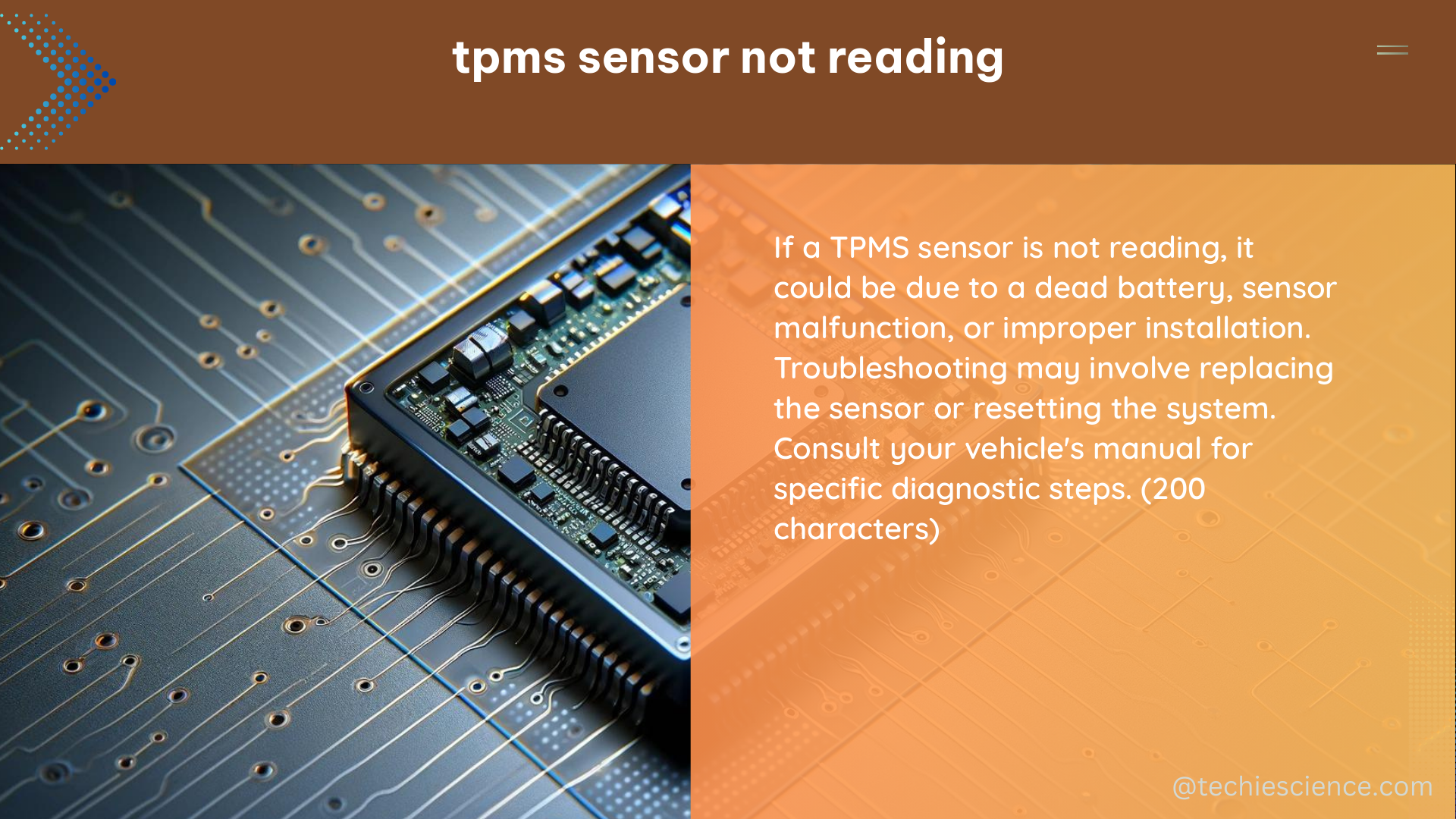TPMS (Tire Pressure Monitoring System) sensors play a crucial role in ensuring the safety and efficiency of a vehicle’s tires. However, there are instances when these sensors fail to read or provide accurate data. This comprehensive guide will delve into the specifics of TPMS sensor issues, focusing on the question of why a TPMS sensor may not be reading, along with technical specifications and a DIY approach to resolving the problem.
Measurable and Quantifiable Data on TPMS Sensor Not Reading
Frequency and Tolerances
TPMS sensors typically operate at a frequency of 433 MHz or 315 MHz, depending on the vehicle make and model. These sensors have a tolerance of around 2-3 psi, meaning that they may read up to 2-3 psi higher or lower than the actual tire pressure. For example, if the actual tire pressure is 35 psi, the TPMS sensor may read between 32-38 psi, which is within the acceptable tolerance range.
Initialization and Learning Time
TPMS sensors may require a certain amount of time to initialize and learn new wheel positions. The learning process can vary depending on the vehicle make and model. For instance, in the case of a Porsche 991, it may take several minutes for the sensors to learn and register the new wheel configuration after a tire rotation or replacement.
Battery Life
TPMS sensors are equipped with batteries that typically last between 5 to 10 years, depending on the sensor’s usage and environmental conditions. A weak or dead battery may prevent the sensor from providing accurate readings or cause it to stop functioning altogether. It’s important to monitor the battery life of TPMS sensors and replace them when necessary.
Interference and Range
TPMS sensors have a limited range, typically around 40-50 feet, and may experience interference from other electronic devices or metal objects, which can affect their ability to transmit data accurately. Factors such as the vehicle’s location, the presence of nearby electronic devices, and the sensor’s positioning can all contribute to interference and range issues.
Valve Stem Condition
A damaged or corroded valve stem can prevent the TPMS sensor from providing accurate readings or may cause the sensor to malfunction altogether. The valve stem is the physical connection between the TPMS sensor and the wheel, and any issues with the valve stem can disrupt the sensor’s ability to measure and transmit tire pressure data.
Technical Specifications of TPMS Sensor Not Reading

Frequency and Communication Protocol
TPMS sensors use either 433 MHz or 315 MHz frequency for communication, with the specific frequency depending on the vehicle make and model. The communication protocol may also vary, with some vehicles using a proprietary protocol and others adhering to industry standards such as ISO 14230 or ISO 15765.
Sensor Design and Components
TPMS sensors consist of several key components, including a pressure transducer, an antenna, a microcontroller, a power source (battery), and a radio frequency (RF) transmitter. The pressure transducer is responsible for measuring the tire pressure, while the antenna and RF transmitter are used to communicate the data to the vehicle’s ECU (Electronic Control Unit).
Sensor Mounting and Positioning
TPMS sensors are typically mounted on the valve stem of each wheel and must be positioned correctly to ensure accurate readings. Factors such as wheel size, tire type, and vehicle make and model can affect the sensor’s positioning and mounting. Improper installation or positioning can lead to inaccurate readings or sensor malfunctions.
DIY Approach to TPMS Sensor Not Reading
Initialization and Learning Process
To initialize and teach TPMS sensors to recognize new wheel positions, follow these steps:
- Ensure that the tires are properly inflated to the recommended pressure.
- Turn on the vehicle’s ignition without starting the engine.
- Use the vehicle’s TPMS reset function (usually found in the instrument cluster or infotainment system) to initiate the learning process.
- Follow the on-screen instructions to complete the learning process, which may involve driving the vehicle at certain speeds or for a specific distance.
Battery Replacement
To replace a TPMS sensor battery, follow these steps:
- Identify the sensor model and purchase a replacement battery that matches the specifications. Common TPMS sensor battery types include CR1632, CR2032, and CR2450.
- Use a TPMS sensor removal tool to safely remove the sensor from the valve stem.
- Follow the manufacturer’s instructions to replace the battery, being careful not to damage any of the sensor’s components.
- Reinstall the sensor onto the valve stem and ensure that it is securely fastened.
Valve Stem Replacement
To replace a damaged or corroded valve stem, follow these steps:
- Purchase a replacement valve stem that matches the vehicle’s specifications, including the thread size and length.
- Use a valve stem removal tool to safely remove the old valve stem from the wheel.
- Install the new valve stem, ensuring that it is properly aligned and securely fastened.
- Install the TPMS sensor onto the new valve stem and ensure that it is securely fastened.
References
- Rennlist – TPMS Sensors not learning – Porsche Discussion Forums
- CorvetteForum – New TPMS Sensor readings do not match manual tire gauge
- ClubLexus – ECU not reading TPMS sensors – Lexus Forum Discussion

The lambdageeks.com Core SME Team is a group of experienced subject matter experts from diverse scientific and technical fields including Physics, Chemistry, Technology,Electronics & Electrical Engineering, Automotive, Mechanical Engineering. Our team collaborates to create high-quality, well-researched articles on a wide range of science and technology topics for the lambdageeks.com website.
All Our Senior SME are having more than 7 Years of experience in the respective fields . They are either Working Industry Professionals or assocaited With different Universities. Refer Our Authors Page to get to know About our Core SMEs.